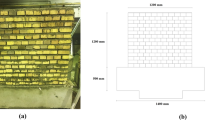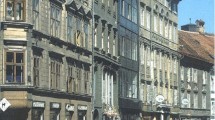Abstract
The application of three different intervention techniques on three-leaf rubble stone masonry walls are discussed here. Injections, repointing, and the placing of ties connecting the two external whytes were considered, both singularly and in combination. Lime-based products were chosen for injection grouts and repair mortars, to ensure better compatibility with the original materials. The experimental tests, performed on seventeen large scale samples under compressive loads, showed that: (i) injections are very effective to improve the mechanical characteristics of the walls; (ii) the other techniques have less influence on the strength but can operate in avoiding ‘brittle’ failure modes (ties placing) and in improving the durability of the masonry (repointing); (iii) the combination of the techniques ensures the enhancement of the global behavior of the walls. The integration of the experimental results with data available in literature allowed the calibration of an analytical model able to predict the compressive strength of injected walls, based on parameters given by simple experimental tests.
Résumé
Dans cet article, nous allons observer l'application de trois différentes techniques d'intervention sur des murs de trois couches en maçonnerie de pierres. Les injections, le remplissage des joints horizontaux de mortier et le positionnement des épingles qui relient les deux couches extérieures ont été pris en considération à la fois individuellement et ensemble. Des produits à base de chaux ont été choisis pour les injections de coulis et les mortiers de réparation, afin d'assurer une meilleure compatibilité avec les matériaux d'origine. Les tests expérimentaux effectués sur dix-sept échantillons à grande échelle sous l'action de poids comprimant, ont montré que: (i) les injections améliorent considérablement les caractéristiques mécaniques des murs; (ii) les autres techniques influencent moins la résistance mais elles peuvent opérer en évitant les modes d'éches ‘fragile’ (avec le positionnement des chaînes) et en améliorant la durabilité de la maçonnerie (remplissage des joints); (iii) la combinaison des techniques assure l'amélioration globale du comportement des murs. L'intégration des résultats expérimentaux avec les données disponibles en littérature ont permis de calibrer un modèle analytique capable de prévoir la force de compression des murs injectés, fondée sur les paramètres résultant de simples tests expérimentaux.
Similar content being viewed by others
References
Binda, L., Baronio, G., Penazzi, D., Palma, M. and Tiraboschi, C., ‘Characterization of stone masonry walls in seismic areas: data-base on the masonry sections and materials investigation’, in ‘L'ingegneria Sismica in Italia’, Proceedings of the 9th National Conference, Turin, Italy, (1999) (14 p., on CD-ROM) (only available in Italian).
Egermann, R., ‘Stone masonry buildings: research and applications at the University of Karlsruhe’, in ‘Murature Sicurezza Recupero’, Proceedings of the Conference of ITEA, Trento, Italy (1993) 70–95 (only available in Italian).
Egermann, R., ‘Investigation on the load bearing behaviour of multiple leaf masonry’, in ‘Structural Preservation of the Architectural Heritage’, Proceedings of the IABSE Symposium, Rome, Italy (ETH Ed., Zurich, Switzerland) (1993) 305–312.
Vintzileou, E. and Tassios, T.P., ‘Three-leaf stone masonry strengthened by injecting cement grouts’,J. Structural Eng., ASCE (May 1995) 848–856.
Binda, L., Gambarotta, L., Lagomarsino, S. and Modena, C., ‘A multilevel approach to the damage assessment and seismic improvement of masonry buildings in Italy’. In ‘Seismic Damage to Masonry Buildings’ (Bernardini Ed., Balkema, Rotterdam, The Netherlands) (1999) 179–194.
da Porto, F., ‘Experimental investigations for the effectiveness of consolidation techniques on historic stone masonry walls’, Graduation thesis, University of Padova, Padova, Italy (2000) (only available in Italian).
Baronio, G., Binda, L. and Modena, C., ‘Criteria and methods for the optional choice of grouts according to the characteristic of masonry’, in ‘Effectiveness of Injection Techniques for Retrofitting of Stone and Brick Masonry Walls in Seismic Areas’, International Workshop CNR-GNDT, Polytechnic of Milan, Milan, Italy (L. Binda Ed., Milan, Italy) (1992) 139–157.
Binda, L., Modena, C., Baronio, G. and Gelmi, A., ‘Experimental qualification of injection admixtures used for repair and strengthening of stone masonry walls’, Proceedings of the 10th International Brick/Block Masonry Conference, Calgary, Canada, Vol. 2 (1994) 539–548.
Valluzzi, M.R., ‘Mechanical behavior of historic masonry walls consolidated with lime-based materials and techniques’, Ph.D. Thesis, University of Trieste, Trieste, Italy (2000) (only available in Italian).
Valluzzi, M.R., Binda, L. and Modena, C., ‘Experimental and analytical studies for the choice of repair techniques applied to historic buildings’,Mater. Struct. 35 (2002) 285–292.
Binda, L., Fontana, A. and Anti, L. ‘Load transfer in multiple leaf masonry walls’, Proceedings of the 9th International Brick/Block Masonry Conference, Berlin (DGfM Ed., Bonn, Germany) (1991) 1488–1497.
Toumbakari, E.E. and Van Gemert, D., ‘Lime-pozzolana cement injection grouts for the repair and strengthening of three leaf masonry structures’, Proceedings of the 4th International Conference on the Conservation of Monuments in the Mediterranean Basin, Rhodes, Greece (3) (1997) 385–394.
Pisano, F., ‘Validity of physical models on the study of injections applied to historic three-leaf masonry walls’, Graduation thesis, Polytechnic of Milan, Milan, Italy (1999) (only available in Italian).
Author information
Authors and Affiliations
Additional information
Editorial note Prof. Claudio Modena is a RILEM Senior Member. He participates in RILEM TC 177-MDT ‘Masonry durability and on-site testing’.
Rights and permissions
About this article
Cite this article
Valluzzi, M.R., da Porto, F. & Modena, C. Behavior and modeling of strengthened three-leaf stone masonry walls. Mat. Struct. 37, 184–192 (2004). https://doi.org/10.1007/BF02481618
Received:
Accepted:
Issue Date:
DOI: https://doi.org/10.1007/BF02481618




